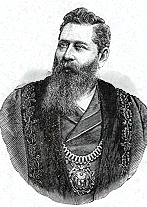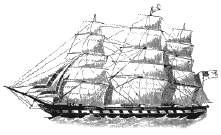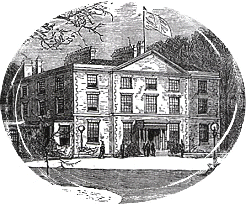 |
 |
 |
The
International
Shipperies Exhibition
A Massive
Undertaking
The Liverpool Mercury always
had delusions of grandeur, manifesting itself in self-righteous monologues in
one paragraph to patronising diatribes in another, but the impending arrival of
Queen Victoria sent the whole newspaper into the literary equivalent of a
swoon. Months before her arrival there were small articles which grew
bigger as the time grew nearer, rising to a crescendo of jingoism in the week
before.
The reason for her visit was to formally open the International Shipperies
Exhibition in May, 1886, to be held in Wavertree Park ( Botanic Park to many
). The Queen was no stranger to Exhibitions and had opened the greatest of
them all to date which was the Great Exhibition at Crystal Palace in 1851.
She had taken a special interest in that one because her Prince Consort, Albert
had been a prime mover in its inception. Napoleon the Third and Eugenie
had visited the Crystal Palace and he was so impressed that he immediately
ordered that Paris should hold her own Exhibition which was held in 1855 on the
Champs Elysees. Paris became fascinated by the idea of Exhibitions and
began to have one after the other, culminating in the greatest of them all in
1889 when the Eiffel Tower was the centre of attraction. The cities of the
British Empire had also taken up the idea with Toronto holding an Exhibition in
1878 and others were in as far flung parts of the Empire as Delhi. Even
the United States began to take an interest and in 1893, the Chicago Exhibition
had as its centre-piece the Ferris Wheel. The main idea of these Exhibitions was
to celebrate the achievements of the particular country which was holding them,
to showcase the latest scientific inventions and to promote trade between
participating countries but in England there was also a grander scheme which was
to celebrate and bring together the countries of the Empire. The Liverpool
Exhibition boasted every element of a successful Exhibition and an added
attraction was the arrival on the Mersey of Brunel's The Great Eastern
which could be boarded by sightseers who little knew they would be some of the
last to see the great ship. It was only two years later that it could be
seen on the Mersey as a sad hulk awaiting the scrap yard.
The highlight of the Queen's visit was of course the opening ceremony of
the International Exhibition of Navigation, Travel, Commerce and Manufacture,
shortened by most people to the Shipperies Exhibition. The Exhibition was
adjacent to  and overlooking Wavertree Park and its Botanic Gardens and the
combined effect of the Exhibition and an established and scintillating gardens
was stunning. For anyone who had never previously visited the area the
effect could have been nothing less than overwhelming and could not have been
covered in a day. The amount of work required to bring the Exhibition to
fruition was staggering and even before any aesthetic work could be done the
preliminary work was overwhelming. There was firstly the little matter of
purchasing the land which was in the ownership of the inhabitants of Edge Lane
Hall and the estate which had fallen into disuse. Plans to demolish the
house were shelved and it remained as part of the Exhibition. An
unexpected turn of events was the soft ground which was too marshy to maintain
the Exhibition Hall and no less than 2,000,000 bricks were cemented as
footings. The Pavilion itself was the centre-piece of the show and in what
amounted to an incredibly bold decision the Exhibition organisers decided to
purchase the gigantic Antwerp International Exhibition Hall. The iron
framework and tons of glass were duly transported by ship to Liverpool docks
from Antwerp but not before several pieces of ironwork were lost overboard in a
gale. The ship was lucky to survive the battering and the whole adventure could
have literally foundered there and then bu
and overlooking Wavertree Park and its Botanic Gardens and the
combined effect of the Exhibition and an established and scintillating gardens
was stunning. For anyone who had never previously visited the area the
effect could have been nothing less than overwhelming and could not have been
covered in a day. The amount of work required to bring the Exhibition to
fruition was staggering and even before any aesthetic work could be done the
preliminary work was overwhelming. There was firstly the little matter of
purchasing the land which was in the ownership of the inhabitants of Edge Lane
Hall and the estate which had fallen into disuse. Plans to demolish the
house were shelved and it remained as part of the Exhibition. An
unexpected turn of events was the soft ground which was too marshy to maintain
the Exhibition Hall and no less than 2,000,000 bricks were cemented as
footings. The Pavilion itself was the centre-piece of the show and in what
amounted to an incredibly bold decision the Exhibition organisers decided to
purchase the gigantic Antwerp International Exhibition Hall. The iron
framework and tons of glass were duly transported by ship to Liverpool docks
from Antwerp but not before several pieces of ironwork were lost overboard in a
gale. The ship was lucky to survive the battering and the whole adventure could
have literally foundered there and then bu t after a collective sigh of relief
the building finally reached the showground. The building had a
"Crystal-Palace" look about it and many of the exhibits were to be
housed within its cavernous interior. There was a road built which
traversed Edge Lane to Wavertree Road { called Exhibition road ---the art-deco
Littlewooods building stands where the road was built } and a temporary railway
station built next to a new rail-line. The infrastructure was coming
together and like many another similar project momentum was gathering and after the initial set-backs had been met head-on and
overcome there was no stopping it. Several European countries were main
contributors and the rail system was the key to transporting the exhibits ---as
such several European governments cut the carriage rates to accommodate the vast
amount of materials being carried and to help in such a prestigious
undertaking. Once the framework of the "Crystal-Palace" had been
put in place and the thousands of glass panes inserted everything else
began to fall into place around its stupendous 100 foot high domes.
t after a collective sigh of relief
the building finally reached the showground. The building had a
"Crystal-Palace" look about it and many of the exhibits were to be
housed within its cavernous interior. There was a road built which
traversed Edge Lane to Wavertree Road { called Exhibition road ---the art-deco
Littlewooods building stands where the road was built } and a temporary railway
station built next to a new rail-line. The infrastructure was coming
together and like many another similar project momentum was gathering and after the initial set-backs had been met head-on and
overcome there was no stopping it. Several European countries were main
contributors and the rail system was the key to transporting the exhibits ---as
such several European governments cut the carriage rates to accommodate the vast
amount of materials being carried and to help in such a prestigious
undertaking. Once the framework of the "Crystal-Palace" had been
put in place and the thousands of glass panes inserted everything else
began to fall into place around its stupendous 100 foot high domes.
The
show-ground was to be filled with what the Liverpool Mercury called "a
heterogeneous aggregation of
exhibits" but what we would call an eclectic collection of exhibits
and displays celebrating Liverpool's great maritime heritage as its theme. As the day drew nearer, the Liverpool Mercury's coverage grew longer and
more detailed but they weren't above a little snippet of gossip here and there
although it was a far cry from today's screaming headlines. In between
descriptions of the Royal train at Edge Hill, they happened to mention that the
Queen would be accompanied by the brother of John Brown and that the Queen was
now aged 67.
Queen to L7
The Exhibition was to be formally opened by the Queen in person and she was to
spend three days as a guest  of the city. As one of the foremost cities of
the Empire and one of the greatest ports in the world the visit of the Queen was
a unique accolade and set the seal not only upon the Exhibition but all that
Liverpool stood for in the Victorian canon. It was also a personal triumph
for the Lord Mayor, David Radcliffe, whose energy and foresight had instigated
the whole thing and it earned him the title Sir David Radcliffe during the
Queen's visit. The
Queen's home during her stay was Newsham House on Judges Drive within the rural
setting of Newsham Park where she had the unique experience of listening to a
concert from a theatre in the city via the cutting edge invention called the
telephone ---the listener was called an" ear- witness". Just a short distance away on the other side
of the park the Queen paid a visit to the Seamen's Orphanage. The
orphanage is a massive building, erected in 1874, and its very size is a testament to Liverpool's
heavy involvement with the sea and the price many paid with the
of the city. As one of the foremost cities of
the Empire and one of the greatest ports in the world the visit of the Queen was
a unique accolade and set the seal not only upon the Exhibition but all that
Liverpool stood for in the Victorian canon. It was also a personal triumph
for the Lord Mayor, David Radcliffe, whose energy and foresight had instigated
the whole thing and it earned him the title Sir David Radcliffe during the
Queen's visit. The
Queen's home during her stay was Newsham House on Judges Drive within the rural
setting of Newsham Park where she had the unique experience of listening to a
concert from a theatre in the city via the cutting edge invention called the
telephone ---the listener was called an" ear- witness". Just a short distance away on the other side
of the park the Queen paid a visit to the Seamen's Orphanage. The
orphanage is a massive building, erected in 1874, and its very size is a testament to Liverpool's
heavy involvement with the sea and the price many paid with their lives.
There was an embarrassing moment for the matron when the ritual of signing the
visitors book came around ---the Queen of course was accustomed to signing
such things and signed as usual "Queen Victoria" followed by her
titles which made quite a long list. The matron signed on a line further
down with the one word "Fanny" which was her Christian name. The
Queen was reported to have found this highly amusing and so did everyone else
when the Mercury dutifully reported the incident. The orphanage today has
fallen into disuse. Its original purpose is thankfully redundant and the building stands for all the
world like a prisoner in the dock awaiting sentence.
Victoria
began the opening ceremony in front of the imposing St.Georges Hall where a
crowd of thousands
were gathered. Most of the crowd had umbrellas raised but despite the
rain, the Queen drove in an open carriage, past the cheering crowds, past
the
Wellington Monument, turning up London Road and onto Princes Park, driving past
Edge Hill and onto the main entrance along the newly built Exhibition
road. The
main entrance was half-way along Botanic road where she was met by the Band of
The Grenadier Guards playing Rule Britannia. The words of the tune
escaped most people but even if they had noticed " Britons never, never,
never will be slaves" they would have been completely oblivious to the
ironies of how and why Liverpool had such a scintillating maritime
history. A Wavertree man, Mr O.Connor had designed an ingenious key
which Chubb had engineered in gold and presented free of charge to the
city. The Queen was formally presented with the key and no doubt Mr
O'Connor had some anxious moments as she turned it in its lock to open all
twelve gates to the main building at one time.
The Shipperies Exhibition
By this time the Liverpool
Mercury had gone into raptures and having seen the
Exhibition in all its glory one journalist was inspired to give out the followi ng advice ;
ng advice ;
" By the expenditure of a few shillings the
busy
artisan or labourer who lives at a distance may transport himself and his family
from his place of toil to where the accumulated treasures of the Exhibition,
together with its auxiliary amusements are open to them."
The queen was then escorted around the showground with its maritime
theme well represented within the setting of the fabulous gardens and parkland
and the first thing she would have seen would have been the life-size copy of
the Eddystone Lighthouse, 170 feet tall. Within the same context, the rowing boat that Grace
darling
and her father carried out their famous rescue was also on show.
Grace Darling was a lighthouse keeper's
daughter on the Farne Islands, off the coast of Scotland. When the
Forfarshire was wrecked in a great storm in the winter of 1831, a number of
survivors were stranded on rocks and in immediate danger of being washed away by
the heavy seas. Grace and her father twice rowed across and took off the
survivors in their small boat ----- a measure of their courage is that the
storm was so fierce that the lifeboat was unable to be launched. Grace's
exploits immediately captured the imagination of the public, Wordsworth was
moved to write a poem in her praise and she was elevated to the sisterhood of
Victorian heroines and became a household name throughout the era.
There were numerous maritime inventions on show and a local man Mr. W.S. Roberts
of 57 Deane Road ( just a stone's throw from the showground ) had on display his
Spontaneous Boat Release mechanism which was universally acclaimed for its combi nation of simplicity and ingenuity. the Austrian entry of a
Signalling Apparatus was so acclaimed as to be bought by several countries for
use in their ships. The number and quality of the inventions were reported
to be of great interest to the numerous seamen who attended the show.
nation of simplicity and ingenuity. the Austrian entry of a
Signalling Apparatus was so acclaimed as to be bought by several countries for
use in their ships. The number and quality of the inventions were reported
to be of great interest to the numerous seamen who attended the show.
Most of the non sea-going fraternity would have been more interested in the
exhibits representing countries from around the Empire which were as exotic as
they were unattainable --for every mariner who had travelled the world there
were a hundred "artisans" who would never travel further than New
Brighton and London might as well been on the moon. The Liverpool Mercury
was also impressed by the representatives from around the world and went into
detail about the African village and its elephants, camels, bulls etc.
There was a gypsy encampment, Ashanti village, an African village, and so on and
it seems that
the public were encouraged to enter each of the dwellings where they could mix
with the natives and imagine life as it was lived around the globe. For
anyone in any doubt, the Liverpool Mercury explained it all ;
"One can visit the habitations of Asiatics,
Africans and Laplanders and living temporarily in either of these may imitate
Elia in the whimsical humour which enabled him at will to become somebody
else"
The![]() show was ahead of its time in encouraging customer participation and the rides
which were available were favourites with
show was ahead of its time in encouraging customer participation and the rides
which were available were favourites with adults and children alike. The "captive balloon" was
the largest ride ascending to a maximum of 250 feet while the elephant and camel
rides were for the less adventurous and the Canadian toboggan ride was
positively hair-raisingly fast. The Mercury was fascinated by the
rides and went into great detail about them all but seemed to be particularly
attached to transport pulled by human beings with the following observation on
the African representative ;
adults and children alike. The "captive balloon" was
the largest ride ascending to a maximum of 250 feet while the elephant and camel
rides were for the less adventurous and the Canadian toboggan ride was
positively hair-raisingly fast. The Mercury was fascinated by the
rides and went into great detail about them all but seemed to be particularly
attached to transport pulled by human beings with the following observation on
the African representative ;
"Covered hammocks of African origin, the bearers
of which are negroes who although of low stature possess remarkable physical
powers of endurance".
The same journalist was less specific upon the subject of rickshaws
and reported vaguely ;
"But what it will be asked is a Rickshaw
ride. Well it is a sort of perambulator
for grown-up persons and it came from Japan".
After some thought his editor decided not to enter him for the
Pulitzer that year.
 It
was worth visiting the show to see the superb floral displays and gardens alone
and these had been further enhanced by the participation of various
horticultural firms who were anxious to show off their wares within such a
prestigious setting. Electric lighting was still a source of wonder and
apart from "transforming the exhibits into a
Fairyland" the exhibitors were able to work long into the
night. Messrs Dickson and Son who boasted the title "The Queen's
seedsmen" were given the task of decorating much of the showground and used
traditional bedding schemes with flower displays and plants in containers while
Messrs James Samuelson who sold nuts took the opportunity to display a tree or
shrub pertaining to each nut. Mr G. Hutchinson who sold fruit, did exactly
the same thing and against each fruit was shown its relevant tree or shrub.
It
was worth visiting the show to see the superb floral displays and gardens alone
and these had been further enhanced by the participation of various
horticultural firms who were anxious to show off their wares within such a
prestigious setting. Electric lighting was still a source of wonder and
apart from "transforming the exhibits into a
Fairyland" the exhibitors were able to work long into the
night. Messrs Dickson and Son who boasted the title "The Queen's
seedsmen" were given the task of decorating much of the showground and used
traditional bedding schemes with flower displays and plants in containers while
Messrs James Samuelson who sold nuts took the opportunity to display a tree or
shrub pertaining to each nut. Mr G. Hutchinson who sold fruit, did exactly
the same thing and against each fruit was shown its relevant tree or shrub.
But it wasn't just the horticultural firms who took the opportunity to advertise
; Isaac Dixon and Co of The Windsor Ironworks had its offices and factory in
Spekeland road which was just across Picton road and literally two minutes
away. Iron was very much in vogue at that time and Dixon's impressive
boast was that they could build anything of iron and transport it anywhere and
gave examples of their work. On the face of it, there wouldn't seem to be
a great demand for such buildings but strangely enough, it was a very lucrative
trade at the time, in places where
there was a distinct lack of building materials. Dixon's had built their
factory adjacent to the railway station and they transported and built in situ
prefabricated iron buildings anywhere in the country. One of their main
outlets was in the north of Scotland and there are several buildings built by
Dixons still standing. There was no lack of competition and several other
firms throughout the country offered the same service. The Concert
Pavilion in Caernarvon, holding 10,000 people seems to be their most impressive
building but the range and variety are astonishing. There's no sign now in
Spekeland Road that Dixons ever existed and they vanished as quickly as the
fashion in iron buildings.
There were of course adverts for overseas travel and the posters are fascinating
for the number of ships available, the prices and one of them The Vancouver is
" lighted by electric light" . Some of the ships have separate
bathrooms for men and women and there are assisted passages for agricultural
labourers and their families, also to domestic servants.
A Victorian Melodrama
The name William Cross appears throughout the annals of the showground and
always in connection with animals and birds. It seems that all the animal
and bird imports were managed by Mr Cross who also advertised throughout the
show of his firm in Earle St in the city centre which boasted it was "the
largest importer of wild beasts, birds and reptiles in the world" and one
advert states that he imported no less than 80,000 parrots each and every
year. This is an astonishing figure by any standards and Mr. Cross seems
to be bent on single-handedly altering the ecology of the planet. His
advertisement and work stand out as an indictment of the monumental arrogance
shown towards animal and bird life at that time.
There's
a lot to admire about the Victorians, not least their energy, their can-do
philosophy, their initiative and their invention.  Their architecture was
bold, their literature renowned and their art was innovative. But when it
came to the natural world they rampaged across the planet with no thought
whatseover for ecology and a complete disregard for flora and fauna wherever
they found it. The Victorians were great collectors and in their day they
made Great Britain into one huge attic full of everything of interest the world
had to offer. Tiger skins from India, Marbles from Greece, statues from
Rome, mummies from Egypt, butterflies from South America, birds from
Africa, orchids from New Guinea, insects, rocks, plants, paintings and on
and on ----- it wasn't enough to look or even touch, they had to possess.
It was a national obsession to stuff, pin, exhibit and gloat over whatever took
their fancy. They killed and removed and trapped anything and everything
with no thought for the damage they were doing---their philosophy was to take it
no matter what and ship it home no matter how and if any proof is needed of
their profligacy it can be seen in every museum and stately home throughout the
country.
Their architecture was
bold, their literature renowned and their art was innovative. But when it
came to the natural world they rampaged across the planet with no thought
whatseover for ecology and a complete disregard for flora and fauna wherever
they found it. The Victorians were great collectors and in their day they
made Great Britain into one huge attic full of everything of interest the world
had to offer. Tiger skins from India, Marbles from Greece, statues from
Rome, mummies from Egypt, butterflies from South America, birds from
Africa, orchids from New Guinea, insects, rocks, plants, paintings and on
and on ----- it wasn't enough to look or even touch, they had to possess.
It was a national obsession to stuff, pin, exhibit and gloat over whatever took
their fancy. They killed and removed and trapped anything and everything
with no thought for the damage they were doing---their philosophy was to take it
no matter what and ship it home no matter how and if any proof is needed of
their profligacy it can be seen in every museum and stately home throughout the
country.
The strange thing about their lack of sensitivity for other living creatures is
that it occurred when the world was awakening to the wonders of the world around
us and naturalists such as Buffon and Lamarck and Agassiz were showing how
ecology affects us all. Stranger still, is that arguably the greatest
Victorian of them all, Charles Darwin was actively extolling the wonders of the
natural world in a manner which David Attenborough would have understood and
applauded.
The complete disregard for the natural world by the Victorians was not
unique and was certainly carried out by others
throughout the world but what was unique was the Victorian's reason for the
damage they caused. That reason was simply a child-like obsession to
possess whatever took their fancy and in that way they encouraged such people as
William Cross who would have no doubt had to resort to other work in the absence
of their obsessive desires.
Even as late as the 1950's, animal life was being treated with an arrogant
disregard. There was a pet-shop at the top of Smithdown road for many
years which sold animals in conditions which would not be allowed today with the
main attraction being a number of chimpanzees in the window on display.
One of the most unthinkingly cruel acts in those days was the purchase of
tortoises as pets. They could be bought at any pet shop in their dozens,
they cost half-a-crown and nearly every family had one. The mortality rate
in the winter was nearly 100% as nobody could maintain enough heat to keep them
alive and worse still another batch came in the shops in spring to replenish
those that had died. There was no overt cruelty involved ---in fact most
people were caring and thoughtful about their exotic pets but the fact is that
just like the Victorians we were taking from nature with no thought for the
environment.
Aftermath
The Crystal-Pa lace which had cost so much and was so impressive was possibly a
source of contention with Dixon's Ironworks who could claim with some
justification that they could have built a new one for far less cost with the
added advantage of being across the road. Strangely, and for no apparent
reason, the Crystal-Place had been dismantled by 1900 and stranger still,
Dixon's Windsor Ironworks of Spekeland Road were commissioned to build a new one
to be called The Tournament Hall which they duly carried out as
required. The Tournament hall was similar to the iron and glass
building it replaced and housed 15.000 spectators. Buffalo Bill and his
Wild West Show played there in 1903 to full houses and local shopkeepers became
used to serving Sioux warriors and cowboys who wandered up and down Wavertree
Road in their spare time. Bishop Chavasse had asked Bill if he would
entertain an open-air Sunday Service and so a motley collection of Cowboys,
Indians and Congregationists all found themselves singing Onward Christian
Soldiers, Rock of Ages, O, God Our Help in Ages Past and many others.
Inevitably, the rain came down but the Service still took place with the Indians
in particular taking a great interest in this strange but invigorating form of
worship.
lace which had cost so much and was so impressive was possibly a
source of contention with Dixon's Ironworks who could claim with some
justification that they could have built a new one for far less cost with the
added advantage of being across the road. Strangely, and for no apparent
reason, the Crystal-Place had been dismantled by 1900 and stranger still,
Dixon's Windsor Ironworks of Spekeland Road were commissioned to build a new one
to be called The Tournament Hall which they duly carried out as
required. The Tournament hall was similar to the iron and glass
building it replaced and housed 15.000 spectators. Buffalo Bill and his
Wild West Show played there in 1903 to full houses and local shopkeepers became
used to serving Sioux warriors and cowboys who wandered up and down Wavertree
Road in their spare time. Bishop Chavasse had asked Bill if he would
entertain an open-air Sunday Service and so a motley collection of Cowboys,
Indians and Congregationists all found themselves singing Onward Christian
Soldiers, Rock of Ages, O, God Our Help in Ages Past and many others.
Inevitably, the rain came down but the Service still took place with the Indians
in particular taking a great interest in this strange but invigorating form of
worship.
Buffalo Bill and The Wild West Show was on its second visit to the city, having
previously played at Shiel Park, over the road from Newsham House in 1891.
There were 350 boys and girls at this show from the Bluecoat Hospital School who
had been allowed in free as a goodwill gesture.  The star of the show was Annie Oakley " Little Sure
Shot" but she was rivalled by the appearance of a horse called Untamed
which nobody could ride and had allegedly killed three men.
The star of the show was Annie Oakley " Little Sure
Shot" but she was rivalled by the appearance of a horse called Untamed
which nobody could ride and had allegedly killed three men.
In actual fact, Buffalo Bill had paid a visit to Liverpool in December 1887 not
as a showman but as a tourist. Playing in Manchester, Buffalo Bill took
the train to Lime St Station accompanied by several of his Indians, Mexicans,
Cowboys and others. He hardly travelled incognito and was welcomed by a
crowd of 30, 000 cheering Liverpudlians who followed him everywhere. The
whole company went to see a play called Shadows of a Great City on the Court
Theatre and returned on the same day having been assured that if they ever
played Liverpool then they would be assured
of an enthusiastic reception.
There is an oral tradition that persists to this day that anyone who had visited
the Buffalo Bill Wild West Show had seen Sitting Bull but although it's a nice
story it has no foundation in fact whatsoever.
The great chief did work in the show it's true but for one season only in 1886
when the show toured America and never left its shores. Apparently,
Sitting Bull was a great success and everyone wanted to see the victor of so
many battles but he declined the offer to stay with the show and tour
Europe. It was a fatal mistake for the great chief as he voluntarily
returned to the reservation where he was killed in suspicious circumstances in
1890. The source of the misunderstanding is that Sitting Bull's son was
taken to be the iconic chieftain himself and given that his name was Young
Sitting Bull it's easy to see where the confusion arose.
Buffalo Bill would have got along with the Victorians quite well
---apart from killing Indians in hand-to-hand knife fights
{ Yellow Hand was the victim } his efforts to single-handedly make the
buffalo extinct were prodigious. To be fair to Buffalo Bill in later life
he was horrified at the thought that he had contributed to the near extinction
of the American Bison and his treatment of the whole tribe of Indians within the
show is nothing but exemplary. But some people never change and in May
1888 before the show was due to return to America there was an auction of
unwanted animals and there at the front with his hand held high was none only
but Mr William Cross who bought 1 Buffalo, 4 Elk and 1 Bear.
In 1925, the site of the Shipperies Exhibition had altered dramatically --- Edge
Lane Hall had been demolished in 1912 and the grounds were all but derelict. The City Council were looking for somewhere to house their fleet
of brand new trams and
Dixon's Tournament Hall was deemed unsuitable for the
purpose and so yet another historic building, a mere 35 years old, fell to the
bulldozers.
In its place a vaguely art-deco, purpose-built tram sheds was
erected consisting of an iron framework and a great deal of glass --- strangely
reminiscent of the Tournament Hall. This eventually became the bus
depot after the sad demise of the trams. Everybody except the City Council
mourned the axing of the tram system and even today there are aficionados who
weep at the mention of the Green Goddesses which were swept away in the manner
of the Overhead Railway. A little vision would have seen both institutions
retained and in use today, no matter what the authorities say. The abiding
nostalgia for the trundling trams meant nothing compared to creating a bus
network and the site eventually became the
biggest bus depot in Europe during the 1950's. The
building was finally demolished in its turn in the 1990's and in the space of
just 100 years three iconic buildings had been built and demolished on the same
site. The area now stands derelict awaiting its latest incarnation which
may even be an iron framework and a glass surround.
The International
Shipperies Exhibition was a resounding success. it opened on May 11th 1886
and remained open until 8th November of the same year. The number of
visitors throughout the show was a staggering 2. 6 million and an equally
astonishing 450,000 exhibitors. It was a celebration of Liverpool and the
Empire at a time when both remained in all their pomp but Edge Hill and
Liverpool 7 would never again reach such heady heights and would fall into a
slow, inexorable decline.
The Exhibitions around
the world are a fascinating subject in their own right and as time went on they
became more and more sophisticated, no doubt engendered by the rivalry which
existed between countries holding them. The Paris Exhibition held by
Napoleon the Third was to rebound upon him in an unexpected manner as the wealth
and creativity of French science was supplemented by a parade of the strength of
the French military. Napoleon just could not resist the temptation to
exhibit the cream of French arms ---unfortunately, the Emperor Wilhelm of
Prussia was in the audience and his realisation that the French army was years
out of date led directly to Napoleon's downfall at Sedan in 1870. The
later French Exhibition of 1889 left a far better legacy with the Eiffel Tower
still proudly symbolic of French ingenuity, the Petit Palais and the Grand
Palais recently renovated and many sculptures and fountains still scattered
throughout the city. The centre-piece of the Chicago Exhibition was
Ferris's wonderful feat of engineering the Ferris wheel and his legacy is often
reproduced throughout the world, most recently with The London Eye. The
Toronto Exhibition still has a monumental, sculptured frontage to its business
park. There is nothing of value whatsoever to recall the International
Shipperies Exhibition and it might never have taken place but for two reminders
----- a pub in Holt road called The Shiipperies and a frieze on the front of the
Picton Library.
The frieze on the fašade of the Library is a relief showing Queen Victoria in
her carriage on her way to the Exhibition and surrounded by officials and a
mounted guard. It is a beautifully sculpted work of art but is so far away
and high up that very few people take notice. The frieze on the other
frontage of the building is a sculpture of the handing over of the city's
charter.